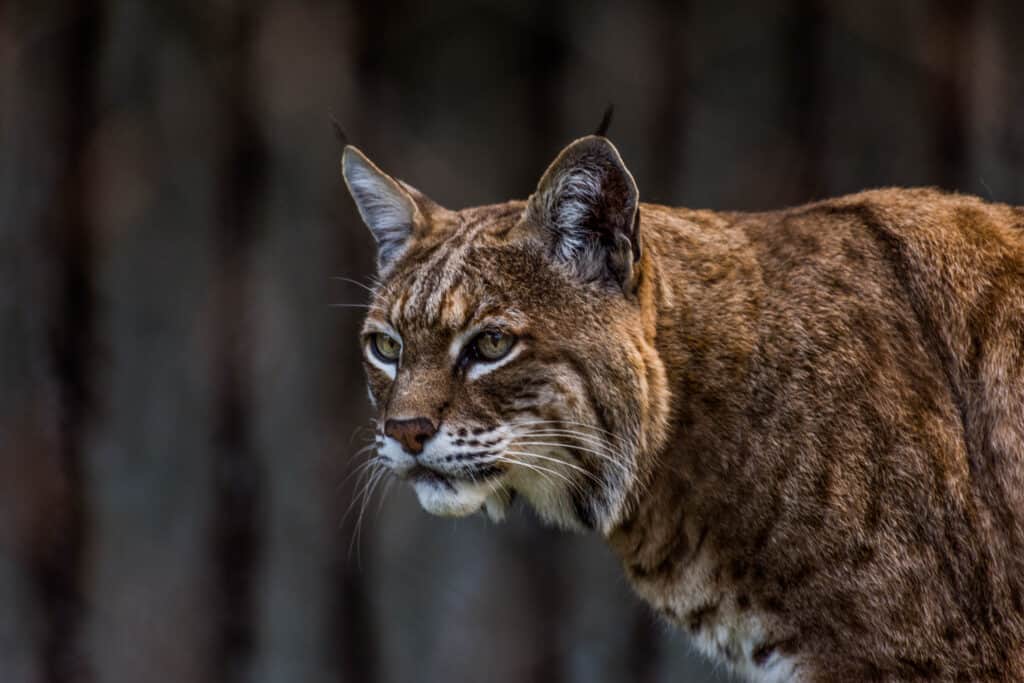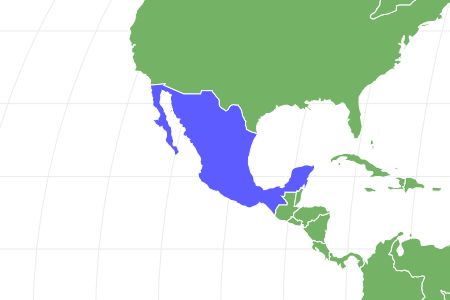Diminutive Woodrat
Nelsonia goldmani goldmani, Nelsonia goldmani cliftoni, Nelsonia neotomodon
The presence of a Nelsonia tail in a tree indicates that these woodrats may be arboreal at times.
Advertisement
Diminutive Woodrat Scientific Classification
- Kingdom
- Animalia
- Phylum
- Chordata
- Class
- Mammalia
- Order
- Rodentia
- Family
- Cricetidae
- Genus
- Nelsonia
- Scientific Name
- Nelsonia goldmani goldmani, Nelsonia goldmani cliftoni, Nelsonia neotomodon
Read our Complete Guide to Classification of Animals.
Diminutive Woodrat Conservation Status
Diminutive Woodrat Facts
- Prey
- Insects
- Fun Fact
- The presence of a Nelsonia tail in a tree indicates that these woodrats may be arboreal at times.
- Biggest Threat
- Logging
- Habitat
- Cool, moist, forested heights.
- Predators
- Snakes, cats, dogs, birds
View all of the Diminutive Woodrat images!
Though there are many species under the broad umbrella of “wood rat,” we will speak here of the genus Nelsonia (diminutive woodrat), which includes two species and one subspecies: the Western diminutive woodrat, Goldman’s diminutive woodrat, and a subspecies of Goldman’s woodrat discovered by Percy Clifton, Nelsonia goldmani cliftoni. These are distinct from the broader group that comes from the genus Neotoma. Western diminutive and Goldman’s diminutive woodrats are rodents from the family Cricetidae. Both species live in Mexico but are extremely difficult to find. Scientists have only recently rediscovered Golden’s diminutive woodrat. The limited data on these species makes it impossible to know any specifics about their behavior, reproduction, or lifespan.
Woodrat Scientific Name
Naming conventions for the Nelsonia genus have undergone several changes since the discovery of these species. When the zoologist Edward Goldman and naturalist Edward Nelson presented specimens later used to identify this genus, they thought they were submitting animals from the genus Peromyscus, otherwise known as deer mice. In 1897, Clinton Hart Merriman, a prominent zoologist and official in the U.S. Department of Agriculture, wrote a paper describing them as a new species named after Nelson.
In 1902, Nelson and Goldman collected two new species of rat, one of which Merriam placed in the Neotoma genus and gave the species the name goldmani, after Goldman. The new species was then identified as connected to the previous discovery, and they were both classified as members of the Nelsonia genus. Researchers designated the first as Nelsonia neotomodon (from the Greek neo, “new,” tomo, “cutting,” don, “tooth”), and the second as Nelsonia goldmani.
In 1968, Percy Clifton discovered another species in Mexico. A paper in the proceedings of the Biological Society of Washington was presented, and the species was named Nelsonia neotomodon cliftoni. Researchers presumed that it was a subspecies of N. neotomodon.
After years of study and research, the current belief is that Nelsonia neotomodon and Nelsonia goldmani are separate species. In contrast, Nelsonia goldmani cliftoni is a subspecies of N. goldmani.
Woodrat Appearance
All of the hairs on N. neotomodon are gray at the base. The upper body has a pinkish hue to the sides with some coarse, darker hairs scattered throughout. The underside is white, as are the feet. The tail of the diminutive woodrat has long hairs of dusty gray on top, with a sharply delineated line of white on the bottom and a white tip. The ears are round and have very few hairs. Its whiskers are incredibly long, reaching back almost as far as half its body length.
Goldman’s diminutive woodrat is similar in size to N. neotomodon, but there are some differences in coloration and skull structure. N. g. goldmani has darker hair on its back, a subtler transition in color between the upper and lower side of the tail, and a dusky coloration to its hind feet. It also has a broader zygomatic plate at the front of the cheekbone than N. neotomodon.
N. goldmani cliftoni has a darker back than the diminutive woodrat, but it’s not as dark as Goldman’s. It also has a shallower skull than N. g. goldmani. All three are between eight-and-a-half and nearly ten inches long.
Woodrat Habitat
Nelsonia neotomodon lives in upper elevations of the Mexican southwest. They like cool, moist, rocky terrains in the ravines and north-facing slopes of Mexico’s mountainous landscape. Also, they will use crevices and stone gaps for shelter. They seem to prefer mossy locales.
Gooldman’s diminutive woodrat lives south of Nelsonia neotomodon in the Trans-Mexican Volcanic Belt. It prefers moist, cool environments in rocky slopes with high-elevation conifer and oak forests. N. g. cliftoni was also collected from the same area and favored a similar habitat.
Woodrat Diet
More study is needed, but the stomach contents of a trapped Goldman’s diminutive woodrat included pine needles, stems, and small insect pieces. They also were observed eating lichen and oak seeds.
Woodrat Predators and Threats
Though scientists have not directly observed predation of the genus Nelsonia, there are a variety of predators in their range. These include bobcats, cougars, snakes, birds, and coyotes.
The environmental impact of habitat disruption resulting from human activities would be of greater significance. Climate change and development practices can have a negative effect on the specific environment required by woodrats to thrive. Pollution, the introduction of invasive species, and lumber extraction add to the stresses already present in the habitat because of disease, pests, and volcanic eruptions.

Though predation of the genus
Nelsoniahas not been directly observed, the bobcat is a predator in their range.
©Victor Arita/Shutterstock.com
Woodrat Population
The IUCN Red List lists the diminutive woodrat as “Least Concern.” Still, they have no population estimate, state that its distribution is “uncommon and locally scarce,” and state that the population is decreasing and severely fragmented.
Nelsonia goldmani is listed in the IUCN Red List as “Nelson and Coldman’s Woodrat,” which is a typo. It should be Goldman’s diminutive woodrat. Its status on The Red List is “Endangered,” with its already rare population decreasing and highly associated with particular microhabitats.
Nelsonia goldmani cliftoni is rare and has not been evaluated by the IUCN.
View all 110 animals that start with DDiminutive Woodrat FAQs (Frequently Asked Questions)
What is the habitat of the diminutive woodrat?
The diminutive woodrat is found in central Mexico near its mountainous and volcanic regions. It prefers high elevations and cool, moist environments, like streams and ravines. It shelters in crevices and ledges.
How do you identify a woodrat?
Diminutive woodrats are approximately nine inches long, and are light or dark gray on top, have a white underside and a bicolor tail with a dusky gray top and white bottom. The hairs on the tail are long, as are their whiskers.
Are woodrats harmful?
Like all rodents, diminutive woodrats are capable of carrying pests and diseases. Given their isolated habitats and remote ranges in Mexico, it is unlikely that they would come into contact with human populations. Like all wild animals, they would bit when threatened.
Thank you for reading! Have some feedback for us? Contact the AZ Animals editorial team.
Sources
- Wikipedia, Available here: https://en.wikipedia.org/wiki/Nelsonia_(rodent)
- Wikipedia, Available here: https://en.wikipedia.org/wiki/Diminutive_woodrat
- Wikipedia, Available here: https://en.wikipedia.org/wiki/Goldman%27s_diminutive_woodrat
- University of Michigan , Available here: https://deepblue.lib.umich.edu/bitstream/handle/2027.42/56996/OP558.pdf;sequence=1
- León-Tapia, M., Zaragoza-Quintana, Elisa, Peralta-Juárez, Claudia, Cervantes, Fernando, 2018/08/30 Morphology and stomach content of the Goldman´s diminutive woodrat Nelsonia goldmani (Cricetidae: Neotominae), Available here: https://www.researchgate.net/publication/327321567_Morphology_and_stomach_content_of_the_Goldmans_diminutive_woodrat_Nelsonia_goldmani_Cricetidae_Neotominae
- Francisco X. González-Cózatl, Rachel M. Vallejo, Elizabeth Arellano, First record of Nelsonia goldmani in the state of Morelos, Mexico, Revista Mexicana de Biodiversidad, Volume 87, Issue 2, 2016, Pages 545-547, ISSN 1870-3453, Available here: https://www.sciencedirect.com/science/article/pii/S1870345316000622
- Biological Society of Washington, Available here: https://www.biodiversitylibrary.org/page/2263451#page/302/mode/1up">https://www.biodiversitylibrary.org/page/2263451#page/302/mode/1up
- The Integrated Taxonomic Information System, Available here: https://www.gbif.org/species/5219812
- De Gruyter Conversations, Available here: https://blog.degruyter.com/wanted-safe-alive-scientists-rediscover-rare-mexican-woodrat-species
- The Biological Society of Washington, Available here: https://biostor.org/reference/74080
- Mindat.org, Available here: https://www.mindat.org/taxon-5219813.html
- Global Biodiversity Information Facility, Available here: https://www.gbif.org/species/196221137
- Global Biodiversity Information Facility, Available here: https://www.gbif.org/species/5219813
- The Biological Society of Washington, Available here: https://upload.wikimedia.org/wikipedia/commons/2/24/Proceedings_of_the_Biological_Society_of_Washington_%28IA_proceedingsofbio16biol%29.pdf

















